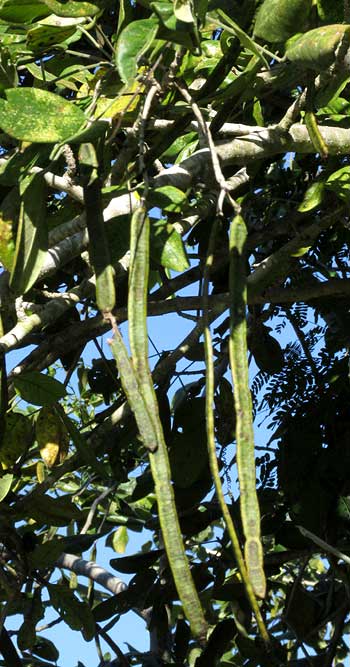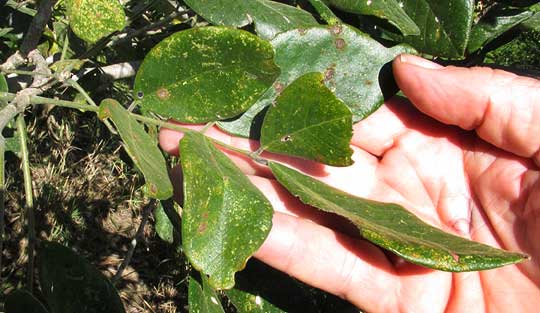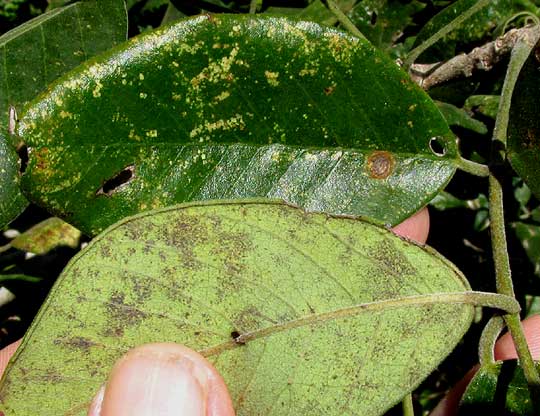Excerpts from Jim Conrad's
Naturalist Newsletter
from the November 23, 2014 Newsletter issued from Río Lagartos, on the Yucatan Peninsula's northern coast (~N21.60°, ~W88.16°), Yucatán state, MÉXICO
YELLOW CANDLEWOOD
At the edge of a dense, weedy patch of scrubby woods in the savanna south of Río Lagartos, a tree about the size of an elephant bore long, slender, flattish, legume-type fruits as shown below:

The leaves were pinnately compound, mostly with five or seven leaflets, rather like leaves of the North's ash trees, as you can see below:

However, the leaves' leaflets were too thick and leathery to be those of a northern ash. Below, they were densely covered with short, soft hairs causing the lower surfaces to be much paler than the glossy upper ones. And the leaflets' stems, or petiolules, were cylindrical in cross section, not somewhat flattish, as often is the case. You can see all this below:

With such a legume-type fruit, and pinnately compound leaves, what family could the little tree belong to other than the enormous Bean Family, the Fabaceae? Moreover, in this part of the world we have so many small trees and shrubs belonging to the Bean Family genus Senna that by now I can recognize the genus, even if I've not encountered that particular species before, and even without seeing the tree's distinctive flowers, as was the case here. This was classic Senna.
It was SENNA ATOMARIA, in English sometimes called the Yellow Candlewood, or simply Senna Tree. Several tree species are known as candlewoods and several Senna species are trees, so these names aren't the best. Fact is, the species just hasn't registered enough in English speaking minds for a good English name to have become attached to it.
And that's a shame, because this is a fine little tree, a human-friendly one that when adorned with its brightly yellow flowers should be very pretty. In tropical lands, because it's such a useful tree, the locals have come up with many names in Creole, Spanish, French and other languages. Two of the most common Spanish ones are Palo de Burro and Palo de Chivo, translatable into English as Burro Tree and Goat Tree, testifying to the interest hungry burros and goats show in them.
Senna atomaria occurs throughout the Caribbean, in Mexico, here and there in Central America and northern South America, plus it's been introduced in various tropical countries, especially in Africa and India. Its natural habitat is hot, dry, low elevations in spotty forest patches, especially in coastal thorn-scrub and often in association with cacti.
Besides serving as fodder for various livestock, it's a fast grower producing serviceable firewood, and while growing contributes to erosion control, not only with its roots holding soil in place but also with its leathery leaves that on the ground below it form a protective covering for soil.
When crushed, the leaves produce a strong smell suggesting medicinal benefits, and in fact in various cultures Senna atomaria leaves are crushed and massaged into the skin to deal with itch and insect bites.